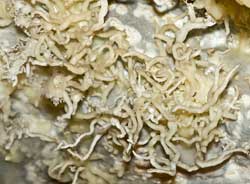| Uses of Caves | Exploring Caves | References | Timpanogos Cave | Lava Tubes |
Cave Features
The decorative dripstone features are called speleothems (from the Greek spelaion for cave and theme for deposit). When these structures are highlighted by lanterns or electric lights, they transform a cave into a natural wonderland.The most familiar speleothems are stalactites and stalagmites. stalactites hang downward from the ceiling and are formed as drop after drop of water slowly trickles through cracks in the cave roof. As each drop of water hangs from the ceiling, it loses carbon dioxide and deposits a film of calcite. Successive drops add ring below ring, the water dripping through the hollow center of the rings, until a pendant cylinder forms. Tubular or "soda straw" stalactites grow in this way; most are fragile and have the diameter of a drop of water, but some reach a length of perhaps a yard or more. The large cone-shaped stalactites begin as these fragile tubes and then enlarge to cones when enough water accumulates to flow along the outside of the soda straws. Deposition of calcite on the outside of the tubes, most of which are near the ceiling and taper downward, results in the familiar cone shapes.
Stalagmites grow upward from the floor of the cave generally as a result of water dripping from overhanging stalactites. A column forms when a stalactite and a stalagmite grow until they join. A curtain or drapery begins to form on an inclined ceiling when the drops of water trickle along a slope. Gradually a thin sheet of calcite grows downward from the ceiling and hangs in decorative folds like a drape. Sheets of calcite that are deposited on the walls or floor by flowing water are called flowstone. Rimstone dams are raised fence-like deposits of calcite on the cave floor that form around pools of water.
 |
| Helictites. |
Most cave passages contain deposits of material that have been washed into the cave. This material, known as cave fill, varies from sand and clay to stratified gravel. The pebbles in these deposits often are highly polished or frosted and sometimes are as large as 6 inches in diameter. Cave fills are particularly noteworthy because they contain materials that reflect a geologic history and a record of past climates of the surrounding area.
Rock material produced by the collapse of the ceiling or walls of a cave is called breakdown and may range in size from plates and chips to massive blocks. Most breakdown present in caves today appears to have occurred thousands of years ago. It is generally associated with the early history of cave development.
The size and depth of many caves in the United States are impressive. Seven caves have more than 15 passage miles. The longest is the Flint-Mammoth Cave system in Kentucky with more than 169 miles. The other six are Jewel Cave in South Dakota (54.4 miles), Organ Cave in West Virginia (32 miles), Wind Cave in South Dakota (28.7 miles), Cumberland Caverns in Tennessee (23.2 miles), Sloan Valley Cave system in Kentucky (22.4 miles), and Crevice Cave in Missouri (20.8 miles).
The deepest cave in the United States is Neff Canyon in Utah. There, a depth of 1,189 feet below the entrance is reached along a steeply sloping 1,700-foot passage. The second deepest cave is Carlsbad Caverns in New Mexico; its lowest point is 1,022 feet below the entrance. Ellisons Cave system in Georgia, a close rival of Carlsbad, has a depth of nearly 1,000 feet.
The largest cave room is in Carlsbad Caverns, where the Big Room covers 14 acres. This room is 1,800 feet long and ranges up to 1,100 feet wide. The maximum height of the ceiling is 225 feet. The size of the Big Room, the length of the caverns (14.9 miles, the 11th longest in the United States), and the depth probably make Carlsbad the biggest cave in the United States.